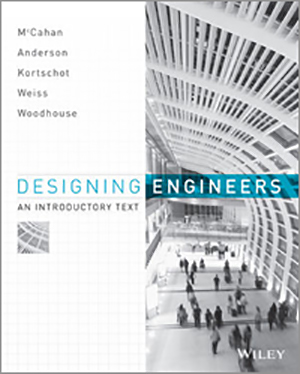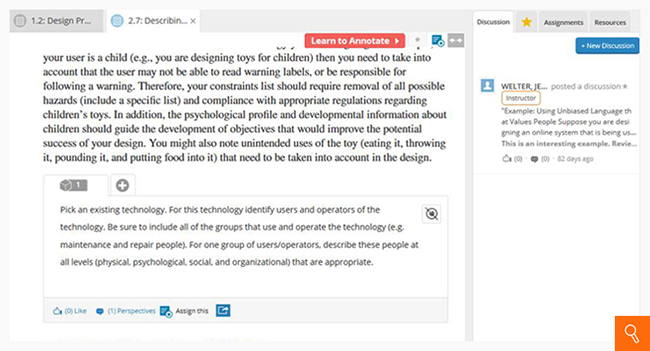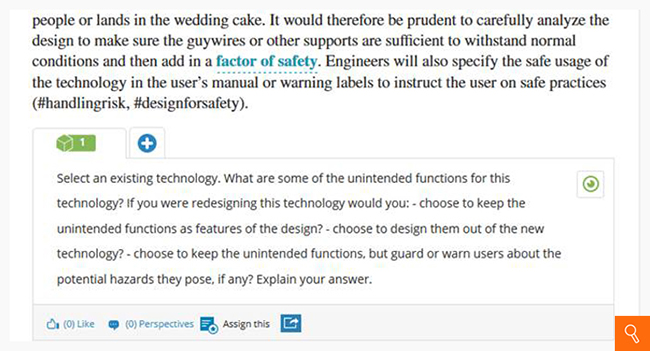
Designing Engineers: An Introductory Text
By Susan McCahan, Phil Anderson, Mark Kortschot, Peter E. Weiss, Kimberly A. Woodhouse
Research shows that learning improves when students think or talk about new concepts. WileyPLUS Learning Space for Designing Engineers gives students the tools and confidence to collaborate with each other and participate more in class.
Schedule a Demo Sign Up for a Test Drive Adopt WileyPLUSWant to learn more about WileyPLUS? Click Here

Concept checkpoints help to reinforce learning
Concept Check Questions follow each reading section, helping students to reinforce and build upon the concepts they just learned.

Students engage with content and each other
Instructors can assign Discussion Questions individually or post them to the Course Stream where students can collaborate and discuss topics.

Skills needed to succeed in the course are continually reviewed
Review Questions at the end of each section are available to instructors to assign as open-ended, manually graded questions.
- Modular – the text is written as a set of discrete modules that can be taught in virtually any selection and order.
- Multidisciplinary – the text roots design concepts in a disciplinary context, enabling students to see how design tasks and roles play out in realistic scenarios.
- Designed for Digital Reading – modules are very brief, thoroughly cross-reference and linked to related topics. Hashtags in the digital edition provide a quick mode of linking and cross-referencing.
- Expert Author Team – The team of authors of Designing Engineers practice the concepts and process of design as outlined in their text.
What’s New
Susan McCahan is currently the Vice Dean, Undergraduate in the Faculty of Applied Science & Engineering at the University of Toronto. She joined the Department of Mechanical & Industrial Engineering at Toronto in 1992. From 2006 to 2011 she served as Chair of First Year for the Faculty. Her research area is energy systems and engineering education. She is a Fellow of the American Association for the Advancement of Science in recognition of contributions to engineering education has been the recipient of several major teaching awards including the 3M National Teaching Fellowship and the Medal of Distinction in Engineering Education from Engineers Canada. She was also part of the team of instructors that received the Alan Blizzard Award for collaborative teaching in 2007. She has developed and taught courses on energy systems, heat transfer, and combustion. Professor McCahan’s current research focuses on the design of the engineering education environment.
Entering the Design Process
Orientation
1. Introduction
2. Design Process Review
3. Phases of a project
4. Communicating through the process
5. What engineers design
6. How design projects are initiated
Navigation
1. The core process cycle
2. School projects
The Core Engineering Design Process
1. Requirements Generation
2. Multi-use Design Tools
3. Idea Generatio
4. Decision Making
5. Iterating
6. Investigating Ideas
7. Post-conceptual Design
The Core Engineering Design Process
1. Requirements Generation
2. Multi-use Design Tools
3. Idea Generation
4. Decision Making
5. Iterating
6. Investigating Ideas
7. Post-conceptual Design
Appendices
Appendix A: Communication & Critical Thinking
1. Critical Thinking
2. Communication
Written
Visual
3. Audio-Visual
Appendix B: Teamwork & Project Management
Teamwork
1. Project Management
Basics of Project Management
Advanced Project Management
Instructions for PM software
1. Interacting with a Client
Appendix C: Design for X
Design for Durability
Design for the Environment
Design for Flexibility
Design for Human Factors
Design for Intellectual Property
Design for Manufacturability
Design for Safety
Design for Testing & Maintenance
Appendix D: Resources
Principles & Problem Solving
Economics
Probability & Statistics
Failure & Risk
Estimation
Case Studies
Glossary

